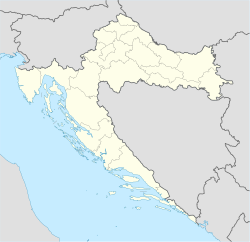준대칭함수
Quasisymmetric function대수학에서, 특히 대수학 결합학에서, quasymmetric 함수는 quasymmetric 함수의 링에 있는 어떤 요소로서, 다시 계산 가능한 수의 변수를 가진 공식 파워 시리즈 링의 서브링이다.이 링은 대칭 함수의 링을 일반화한다.이 링은 n이 무한대로 가듯이 n 변수에 있는 quasymmetric 다항식의 링의 특정 한계로서 실현될 수 있다.이 링은 4대칭 다항식 사이의 관계가 n개의 변수(단, 그 요소는 다항식도 함수도 아니다)와 독립적인 방식으로 표현될 수 있는 보편적 구조의 역할을 한다.
정의들
QSym으로 표시된 Quasymmetric 함수의 링은 정수와 같은 모든 교환 링 R에 걸쳐 정의될 수 있다.Quasisymmetric functions are power series of bounded degree in variables with coefficients in R, which are shift invariant in the sense that the coefficient of the monomial {1}}x_{2}^{\alpha_{2}}}}은 단일 명칭의 x의 계수가 나는 1α 1) 같다 나는 2α 2⋯ x나는 kα k{\displaystyle x_{i_{1}}^{\alpha_{1}}x_{i_{2}}^{\alpha_{2}}\cdots x_{i_{k}}^{\alpha_{k}}}양의 정수의 어떤 강한 증가 결과를 나는 1<>i. x_{k}^{\alpha_{k}\cdots2 < k {\1}<}><\ < 변수와 양의 정수 순서 1 2 ,… k를 지수화하는 것이다.[1]Quasymmetric 함수에 대한 많은 연구는 대칭 함수에 기초한다.
미세하게 많은 변수의 quasymmetric 함수는 quasymmetric 다항식이다.Both symmetric and quasisymmetric polynomials may be characterized in terms of actions of the symmetric group on a polynomial ring in variables . One such action of permutes variables, 연속 지수를 갖는 변수의 쌍, x + )을 반복적으로 스와핑하여 다항식 1,…, n) 를 변경한다그러한 모든 스왑에 의해 변경되지 않은 다항식들은 대칭 다항식의 하위링을 형성한다.A second action of conditionally permutes variables, changing a polynomial by swapping pairs of variables except in monomials containing both variables.그러한 모든 조건부 스왑에 의해 변경되지 않은 다항식들은 Quasymmetric 다항식의 하위링을 형성한다.4개 변수 ,x , x 의 1쿼시 대칭 함수는 다항식이다.
이러한 단수형을 포함하는 가장 단순한 대칭함수는
중요근거점
QSym은 등급이 매겨진 R-algebra로 분해된다.
where is the -span of all quasisymmetric functions that are homogeneous of degree . Two natural bases for are the monomial basis and the fundamental basis indexed by compositions of , denoted .단수 기준은 = 및 모든 공식 파워 시리즈로 구성된다.
기본 바탕은 = 및 모든 공식 파워 시리즈로 구성된다.
여기서 \beta 은(는) 의 인접한 부분을 합쳐서 \alpha \을는) 얻을 수 있다는 것을 의미한다.따라서 이(가) 합리적인 숫자의 링일 때는
Then one can define the algebra of symmetric functions as the subalgebra of QSym spanned by the monomial symmetric functions and all formal power series where the sum is over all compositions which rearrange to the partition . Moreover, we have . For example, and
Quasymmetric 함수의 다른 중요한 기초는 Quasymmetric Schur 함수의 기초와 [2]matroids의 열거에 관련된 기초가 있다.[3][4]
적용들
열거적 결합론, 대칭함수 이론, 표현 이론, 수 이론에 준대칭 함수가 적용되었다.quasymmetric 함수의 적용에는 P-파티션,[5][6] 순열,[7][8][9][10] 표고,[11] 포지셋 체인,[11][12] 유한 Coxeter 그룹의 분해 감소([11]스탠리 대칭함수를 통한), 주차 기능 등이 포함된다.[13]대칭함수 이론과 표현 이론에서 적용은 슈베르트 다항식,[14][15] 맥도날드 다항식,[16] 헤케 알헤브라스,[17] 카즈단-루지그 다항식 연구를 포함한다.[18]종종 Quasymmetric 함수는 결합 구조와 대칭 함수 사이에 강력한 브리지를 제공한다.
관련 알헤브라스
등급화된 Hopf 대수학으로서, Quasymmetric 함수의 링의 이중은 비확정 대칭 함수의 링이다.모든 대칭함수는 또한 준대칭함수로서, 따라서 대칭함수의 링은 준대칭함수 링의 하위대칭함수다.
quasymmetric 함수의 링은 단일 문자로 등급이 매겨진 Hopf Algebras 범주의 단자 객체다.[19]따라서 그러한 모든 호프 대수학에는 quasymmetric 함수의 링에 대한 형태론이 있다.
Malvenuto-Reutenauer 대수학은[21] 대칭함수, 준대칭함수, 비확정대칭함수(각각 Sym, QSym, NSym으로 표기됨)의 링과 관련된 순열을 바탕으로 한 Hopf 대수로서, 다음과 같은 역행도를 나타낸다.위에서 언급한 QSym과 NSym 사이의 이중성은 이 다이어그램의 주요 대각선에 반영된다.
관련된 많은 홉프 알제브라는 아구야르와 마자한에 의해 종의 범주에 속하는 홉프 모노이드로 만들어졌다.[22]
또한 비대칭 변수에 준대칭 함수의 링을 구성할 수 있다.[23][24]
참조
- ^ 스탠리, 리처드 P.케임브리지 대학 출판부 2권 1999. ISBN0-521-56069-1(하드백) ISBN0-521-78987-7(페이퍼백)
- ^ Haglund, J.; Luoto, K.; Mason, S.; van Willigenburg, S. (2011), "Quasisymmetric Schur functions", Journal of Combinatorial Theory, Series A, 118 (2): 463–490, arXiv:0810.2489, doi:10.1016/j.jcta.2009.11.002
- ^ Luoto, K. (2008), "A matroid-friendly basis for the quasisymmetric functions", Journal of Combinatorial Theory, Series A, 115 (5): 777–798, arXiv:0704.0836, Bibcode:2007arXiv0704.0836L, doi:10.1016/j.jcta.2007.10.003
- ^ Billera, L.; Jia, N.; Reiner, V. (2009), "A quasisymmetric function for matroids", European Journal of Combinatorics, 30 (8): 1727–1757, arXiv:math/0606646, Bibcode:2006math......6646B, doi:10.1016/j.ejc.2008.12.007
- ^ 스탠리, 리처드 P.주문된 구조와 칸막이, 미국수학협회의 회고록, 제119호, 미국수학협회의 1972.
- ^ 게셀, 아이라.스큐 슈르 함수, 결합기 및 대수(Boulder, Collo, 1983), 289–317, Isemp의 멀티파티트 P-파티션 및 내부 제품.수학, 34세, 아머수학, 과학, 프로비던스, 리히, 1984년
- ^ Gessel, Ira; Reutenauer, Christophe (1993), "Counting permutations with given cycle structure and descent set", Journal of Combinatorial Theory, Series A, 64 (2): 189–215, doi:10.1016/0097-3165(93)90095-P
- ^ Hyatt, Matthew (2012), "Eulerian quasisymmetric functions for the type B Coxeter group and other wreath product groups", Advances in Applied Mathematics, 48: 465–505, arXiv:1007.0459, Bibcode:2010arXiv1007.0459H, doi:10.1016/j.aam.2011.11.005
- ^ a b c Stanley, Richard P. (1984), "On the number of reduced decompositions of elements of Coxeter groups", European Journal of Combinatorics, 5 (4): 359–372, doi:10.1016/s0195-6698(84)80039-6
- ^ Ehrenborg, Richard (1996), "On posets and Hopf algebras", Advances in Mathematics, 119 (1): 1–25, doi:10.1006/aima.1996.0026
- ^ 하글런드, 제임스;Q,t-Catalan 번호와 대각선 고조파 공간.대학 강의 시리즈, 41.미국 수학 협회, 프로비던스, RI, 2008. 8+167 pp.ISBN 978-0-8218-4411-3; 0-8218-4411-3
- ^ Billey, Sara C.; Jockusch, William; Stanley, Richard P. (1993), "Some combinatorial properties of Schubert polynomials" (PDF), Journal of Algebraic Combinatorics, 2 (4): 345–374, doi:10.1023/A:1022419800503
- ^ Fomin, Sergey; Stanley, Richard P. (1994), "Schubert polynomials and the nil-Coxeter algebra", Advances in Mathematics, 103 (2): 196–207, doi:10.1006/aima.1994.1009
- ^ Assaf, Sami, Dual Equivalence Graphs I: A combinatorial proof of LLT and Macdonald positivity, arXiv:1005.3759, Bibcode:2010arXiv1005.3759A
- ^ Duchamp, Gérard; Krob, Daniel; Leclerc, Bernard; Thibon, Jean-Yves (1996), "Fonctions quasi-symétriques, fonctions symétriques non commutatives et algèbres de Hecke à ", C. R. Acad. Sci. Paris, Sér. I Math., 322 (2): 107–112
- ^ Billera, Louis J.; Brenti, Francesco (2011), "Quasisymmetric functions and Kazhdan–Lusztig polynomials", Israel Journal of Mathematics, 184: 317–348, arXiv:0710.3965, doi:10.1007/s11856-011-0070-0
- ^ Aguiar, Marcelo; Bergeron, Nantel; Sottile, Frank (2006), "Combinatorial Hopf algebras and generalized Dehn–Sommerville relations", Compositio Mathematica, 142 (1): 1–30, arXiv:math/0310016, Bibcode:2003math.....10016A, doi:10.1112/S0010437X0500165X
- ^ Stembridge, John R. (1997), "Enriched P-partitions", Trans. Amer. Math. Soc., 349 (2): 763–788, doi:10.1090/S0002-9947-97-01804-7
- ^ Malvenuto, Clauda; Reutenauer, Christophe (1995), "Duality between quasi-symmetric functions and the Solomon descent algebra", Journal of Algebra, 177 (3): 967–982, doi:10.1006/jabr.1995.1336
- ^ 아구야르, 마르셀로; 마하얀, 스와프넬 모노이드 펑커스, 종과 호프 알제브라스 CRM 모노그래프 시리즈, 29번.미국 수학 협회, 프로비던스, RI, 2010.
- ^ 히버트, 플로렌트, 박사님논문, 마르넬라발레
- ^ Bergeron, Nantel; Zabrocki, Mike (2009), "The Hopf algebras of symmetric functions and quasi-symmetric functions in non-commutative variables are free and co-free", J. Algebra Appl., 8 (4): 581–600, arXiv:math/0509265, doi:10.1142/S0219498809003485

 지수화하는
지수화하는





































